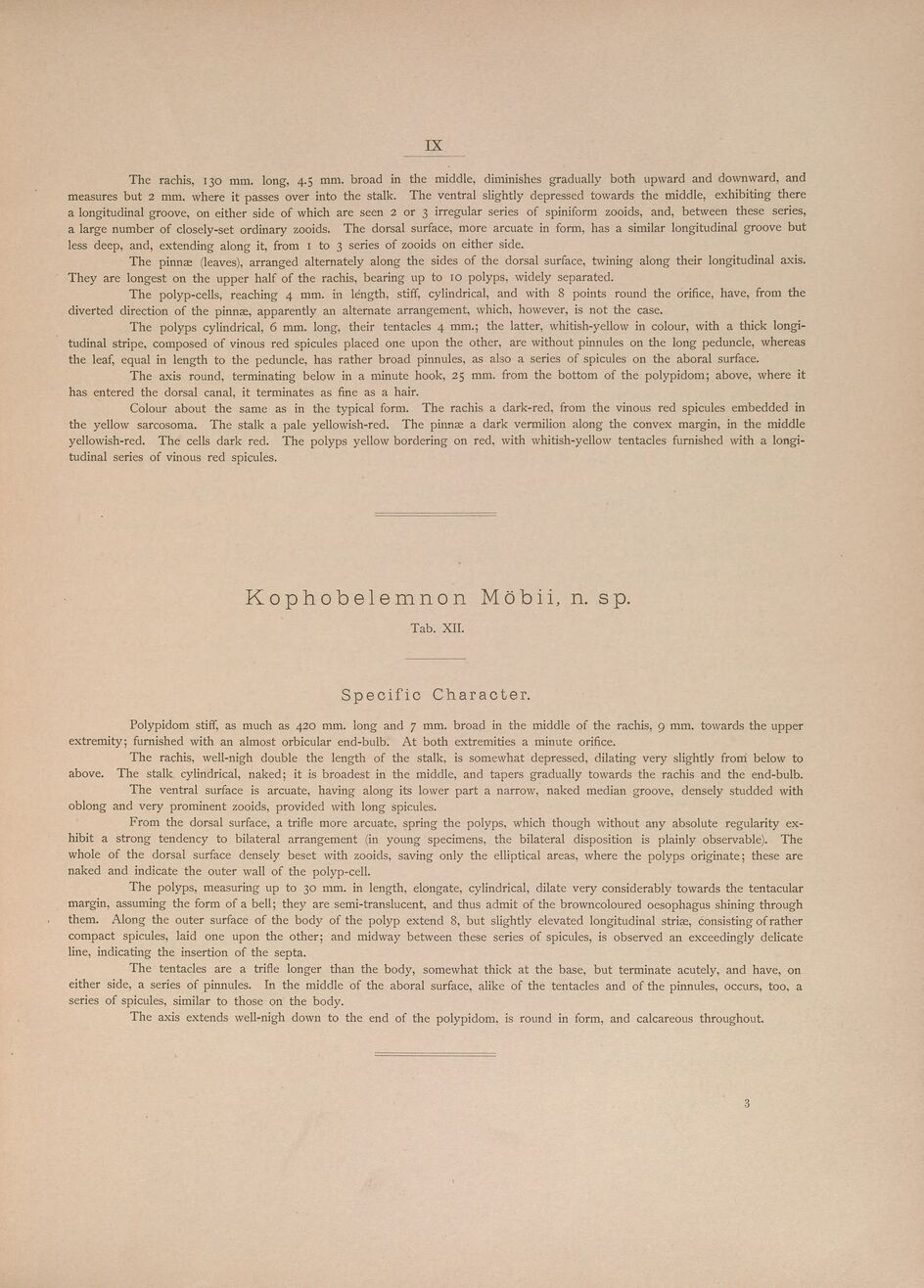
Full resolution (JPEG) - On this page / på denna sida - Sidor ...

<< prev. page << föreg. sida << >> nästa sida >> next page >>
Below is the raw OCR text
from the above scanned image.
Do you see an error? Proofread the page now!
Här nedan syns maskintolkade texten från faksimilbilden ovan.
Ser du något fel? Korrekturläs sidan nu!
This page has never been proofread. / Denna sida har aldrig korrekturlästs.
IX
The rachis, 130 mm. long, 4.5 mm. broad in the middle, diminishes gradually both upward and downward, and
measures but 2 mm. where it passes over into the stalk. The ventral slightly depressed towards the middle, exhibiting there
a longitudinal groove, on either side of which are seen 2 or 3 irregular series of spiniform zooids, and, between these series,
a large number of closely-set ordinary zooids. The dorsal surface, more arcuate in form, has a similar longitudinal groove but
less deep, and, extending along it, from 1 to 3 series of zooids on either side.
The pinnæ (leaves), arranged alternately along the sides of the dorsal surface, twining along their longitudinal axis.
They are longest on the upper half of the rachis, bearing up to 10 polyps, widely separated.
The polyp-cells, reaching 4 mm. in length, stiff, cylindrical, and with 8 points round the orifice, have, from the
diverted direction of the pinnæ, apparently an alternate arrangement, which, however, is not the case.
The polyps cylindrical, 6 mm. long, their tentacles 4 mm.; the latter, whitish-yellow in colour, with a thick
longitudinal stripe, composed of vinous red spicules placed one upon the other, are without pinnules on the long peduncle, whereas
the leaf, equal in length to the peduncle, has rather broad pinnules, as also a series of spicules on the aboral surface.
The axis round, terminating below in a minute hook, 25 mm. from the bottom of the polypidom; above, where it
has entered the dorsal canal, it terminates as fine as a hair.
Colour about the same as in the typical form. The rachis a dark-red, from the vinous red spicules embedded in
the yellow sarcosoma. The stalk a pale yellowish-red. The pinnæ a dark vermilion along the convex margin, in the middle
yellowish-red. The cells dark red. The polyps yellow bordering on red, with whitish-yellow tentacles furnished with a
longitudinal series of vinous red spicules.
Kophobelemnon Möbii, n. s p.
Tab. XII.
Specific Character.
Polypidom stiff, as much as 420 mm. long and 7 mm. broad in the middle of the rachis, 9 mm. towards the upper
extremity; furnished with an almost orbicular end-bulb. At both extremities a minute orifice.
The rachis, well-nigh double the length of the stalk, is somewhat depressed, dilating very slightly from below to
above. The stalk cylindrical, naked; it is broadest in the middle, and tapers gradually towards the rachis and the end-bulb.
The ventral surface is arcuate, having along its lower part a narrow, naked median groove, densely studded with
oblong and very prominent zooids, provided with long spicules.
From the dorsal surface, a trifle more arcuate, spring the polyps, which though without any absolute regularity
exhibit a strong tendency to bilateral arrangement (in young specimens, the bilateral disposition is plainly observable). The
whole of the dorsal surface densely beset with zooids, saving only the elliptical areas, where the polyps originate; these are
naked and indicate the outer wall of the polyp-cell.
The polyps, measuring up to 30 mm. in length, elongate, cylindrical, dilate very considerably towards the tentacular
margin, assuming the form of a bell; they are semi-translucent, and thus admit of the browncoloured oesophagus shining through
them. Along the outer surface of the body of the polyp extend 8, but slightly elevated longitudinal striæ, consisting of rather
compact spicules, laid one upon the other; and midway between these series of spicules, is observed an exceedingly delicate
line, indicating the insertion of the septa.
The tentacles are a trifle longer than the body, somewhat thick at the base, but terminate acutely, and have, on
either side, a series of pinnules. In the middle of the aboral surface, alike of the tentacles and of the pinnules, occurs, too, a
series of spicules, similar to those on the body.
The axis extends well-nigh down to the end of the polypidom. is round in form, and calcareous throughout.
<< prev. page << föreg. sida << >> nästa sida >> next page >>